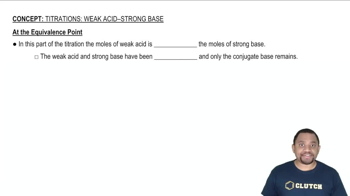Here are the essential concepts you must grasp in order to answer the question correctly.
Titration
Titration is a quantitative analytical technique used to determine the concentration of a solute in a solution. It involves the gradual addition of a titrant (in this case, KOH) to a solution of the analyte (H3PO4) until the reaction reaches its equivalence point, where stoichiometrically equivalent amounts of acid and base have reacted. The pH of the solution changes during this process, and monitoring this change allows for the calculation of the concentration of the unknown solution.
Recommended video:
Equivalence Point
The equivalence point in a titration is the stage at which the amount of titrant added is stoichiometrically equivalent to the amount of substance present in the solution being titrated. For the titration of H3PO4 with KOH, this point can be determined by the complete neutralization of the acid. At this stage, the pH of the solution will be determined by the properties of the resulting salt and any excess base, leading to a significant change in pH.
Recommended video:
pH Calculation
pH is a measure of the acidity or basicity of a solution, defined as the negative logarithm of the hydrogen ion concentration. In titrations, pH can be calculated at various points by considering the concentrations of the reactants and products in the solution. After adding a specific volume of KOH to H3PO4, the resulting pH can be determined by analyzing the remaining acid, the formed salt, and any excess base, using the formula pH = -log[H+].
Recommended video:




